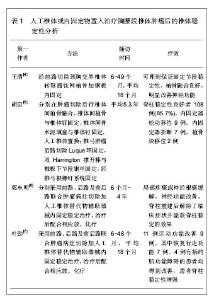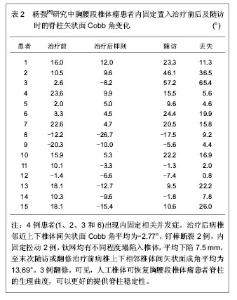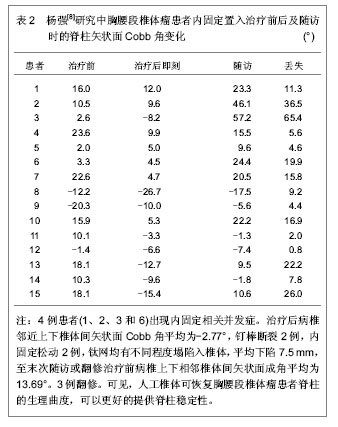| [1] 刘忠军,党耕町,马庆军,等.脊柱肿瘤的全脊椎切除术及脊柱稳定性重建[J].中华骨科杂志,2001,21(11):646-649.[2] Tilleman TR, Richards WG, Zellos L, et al. Extrapleural pneumonectomy followed by intracavitary intraoperative hyperthermic cisplatin with pharmacologic cytoprotection for treatment of malignant pleural mesothelioma: a phase II prospective study. J Thorac Cardiovasc Surg.2009;138(2): 405-411.[3] 中国知网.中国学术期刊总库[DB/OL]. 2013-4-12. https://www.cnki.net[4] 王清.椎体切除植骨融合内固定治疗颈胸交界椎体转移瘤[J].实用骨科杂志,2012,18(12):1100-1102.[5] 胡豇,曾建成,宋跃明,等.胸腰椎肿瘤手术中脊柱稳定性的重建[J].四川医学,2003,24(4):333-335.[6] 郭东明,徐中和,蔡维山,等.胸腰椎转移肿瘤手术切除和稳定性重建[J].广东医学,2004,25(6):683-684. [7] 叶劲,莫茅,蔡维山,等.脊柱重建手术对胸腰椎转移瘤致脊髓功能障碍及疼痛的改善作用[J].中国临床康复,2004,8(23):4690-4691.[8] 杨强.全脊椎整块切除术在治疗胸腰椎肿瘤中的应用及相关研究[D].山东:山东大学,2007:5-6.[9] Boriani S, Weinstein JN, Biagini R.Primary bone tumors of the spine. Terminology and surgical staging.Spine (Phila Pa 1976). 1997;22(9):1036-1044.[10] Casadei R, Greggi T, Miglietta A, et al.Posterior surgery for the treatment of thoracolumbar pathologic fractures in metastatic patients.Chir Organi Mov.1998;83(1-2):149-158.[11] Mazel C, Hoffmann E, Antonietti P, et al.Posterior cervicothoracic instrumentation in spine tumors.Spine (Phila Pa 1976).2004;29(11):1246-1253.[12] Cahill DW, Kumar R.Palliative subtotal vertebrectomy with anterior and posterior reconstruction via a single posterior approach.J Neurosurg.1999;90(1):42-47.[13] Kostuik JP, Errico TJ, Gleason TF, et al.Spinal stabilization of vertebral column tumors.Spine (Phila Pa 1976).1988; 13(3): 250-256.[14] Akeyson EW, McCutcheon IE.Single-stage posterior vertebrectomy and replacement combined with posterior instrumentation for spinal metastasis.J Neurosurg.1996; 85(2):211-220.[15] Fourney DR, Abi-Said D, Rhines LD, et al.Simultaneous anterior-posterior approach to the thoracic and lumbar spine for the radical resection of tumors followed by reconstruction and stabilization.J Neurosurg.2001;94(2 Suppl):232-244.[16] Jónsson B, Sjöström L, Olerud C, et al.Outcome after limited posterior surgery for thoracic and lumbar spine metastases. Eur Spine J.1996;5(1):36-44.[17] Oda I, Cunningham BW, Abumi K, et al.The stability of reconstruction methods after thoracolumbar total spondylectomy. An in vitro investigation.Spine (Phila Pa 1976).1999;24(16):1634-1638.[18] HODGSON AR, STOCK FE, FANG HS, et al. Anterior spinal fusion. The operative approach and pathological findings in 412 patients with Pott's disease of the spine.Br J Surg.1960; 48:172-178.[19] Mirbaha MM. Anterior approach to the thoraco-lumbar junction of the spine by a retroperitoneal-extrapleural technic.Clin Orthop Relat Res.1973;(91):41-47.[20] Moskovich R, Benson D, Zhang ZH, et al.Extracoelomic approach to the spine.J Bone Joint Surg Br.1993; 75(6): 886-893.[21] David S.Bradford主编.卢世璧主译.骨科标准手术技术丛书-脊柱[M].辽宁科学技术出版社,2003:33-41.[22] Kim M, Nolan P, Finkelstein JA. Evaluation of 11th rib extrapleural-retroperitoneal approach to the thoracolumbar junction. Technical note. J Neurosurg.2000;93(1 Suppl): 168-174.[23] Knop C, Blauth M, Bühren V, et al. Surgical treatment of injuries of the thoracolumbar transition--3: Follow-up examination. Results of a prospective multi-center study by the "Spinal" Study Group of the German Society of Trauma Surgery. Unfallchirurg. 2001;104(7):583-600. |



